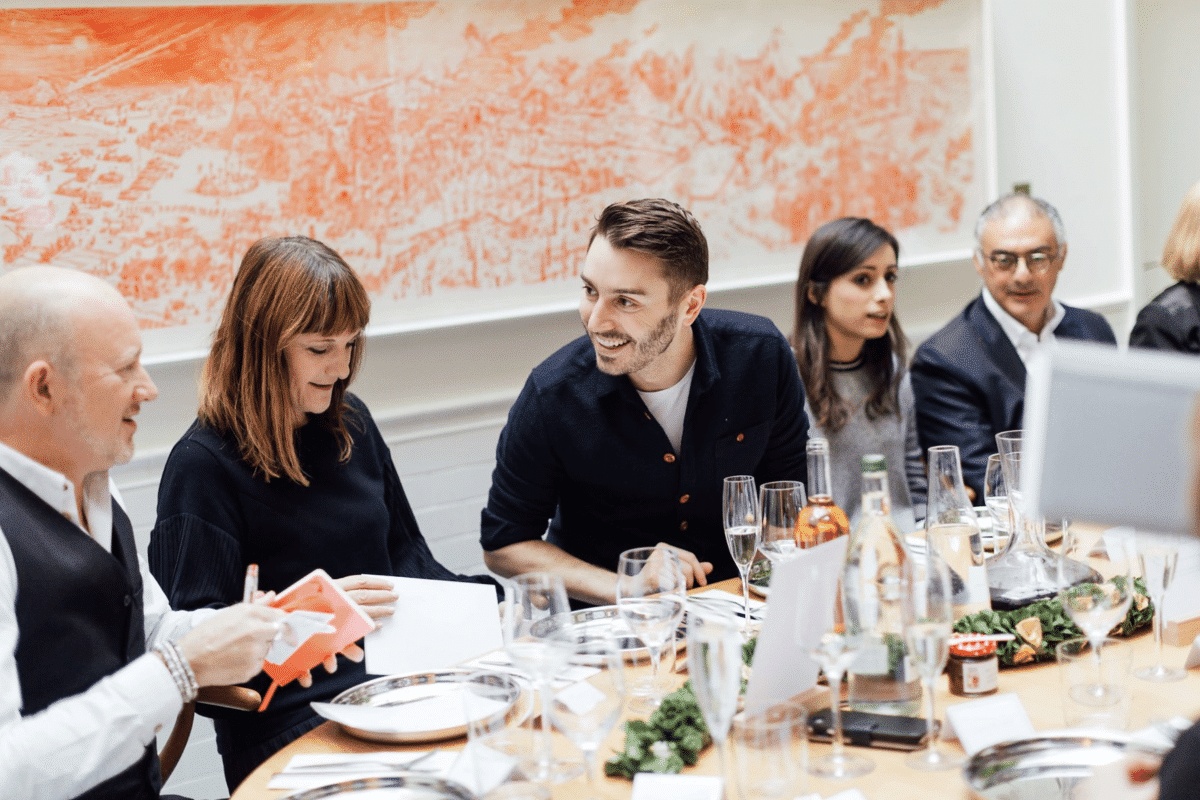




Is interior design a growing market, or is it dying? What are the big opportunities? The conversation began by examining what lies ahead for the profession.
The majority of the round table attendees work in luxury residential with some hospitality projects. Outside of the crowded residential market, the designers were keen to discuss where the next opportunities might lie.
“I think it’s about looking into commercial spaces that we’ve not been bothered to look into as an industry before,” began Lori Pinkerton-Rolet, a former British Institute of Interior Design (BIID) president whose firm Park Grove Design specialises in hotels, care homes and dementia schemes.
“Interior design is about making quality of life for people and making a difference in people’s lives, so we need to ask: where are the spaces that we can really make an impact and add value where we haven’t been able to before?”
She continued: “For healthcare, this has been a hard sell. We’ve really had to demonstrate the difference that interior design can make in people’s lives. It’s now been proven and this market is growing, but I suspect there are other niche markets where this could happen.”
Although it has come a long way, participants agreed that the perception of interior design is still a problem when breaking into new markets. The value design adds to a business or institution can be invaluable but hard to quantify.
Afroditi Krassa, who has created interiors for design-led restaurant chains such as Itsu and Dishoom described how clients need to see a return on their investment and called for the industry to come up with a system for demonstrating the value of luxury interior design to potential clients.
“Good design will pay for itself within a few weeks time in the restaurant world,” she stated. “With design-led restaurants, you can easily prove the effect that design has had. We’ve refurbished bars and restaurants where you can see an immediate jump in sales, and you can prove that.”
She added, “In our industry we are a bit ashamed to talk about money or our work being commercially successful. Unless we can prove as an industry that there is a multiple return on our work, I don’t think our profession will ever be understood.”
Meanwhile, Lori Pinkerton-Rolet described how her studio uses a simple in-house analysis process when working with new hotel clients. By comparing what competing hotels in the area are charging per room, her studio works with the client to analyse the investment against what they could potentially charge per room and the profit they could make on top. “So far we don’t do that as an industry,” she said.
The table agreed that while a system to analyse the success of commercial projects could be implemented by the industry as a whole, residential projects are more complex, as their success is not always measured financially.
“You can’t talk to residential clients from the outset about ROI because there isn’t one,” said Brian Woulfe of London-based luxury interior design studio Designed by Woulfe. “It’s all about their preferences, their personal choice and how they want to live.”“Although I don’t think you can compare residential and commercial in the same way, I do think that the market share is growing,” he added.
I think everybody now realises the value interior designers can add to a project.
Meanwhile Jo Hamilton, who runs her eponymous studio from Belsize Park, London, was keen to highlight the importance of connecting compatible designers and clients. “The trouble is that the clients do not necessarily know the what the architects and interior designers they are hiring can and cannot do.” “I’ve worked on projects where the clients have fabulous ideas but they are quashed by architects again and again.
The architect wants to create a box, and the client wants a bit of personality. How can the client know that he or she is hiring the right team?” The table agreed that although there is a growing appetite for interior design and more respect for the profession, the challenge lies in educating the public and getting design services valued correctly.
The need for an industry-wide ROI analysis system has been exacerbated by increased competition within the industry and the knock-on effect on design fees.

The topic of fees and transparency reoccurred frequently throughout the discussion with all participants agreeing that justifying fees was one the most challenging aspects of running an interior design business today.
Daniel Hopwood, a former BIID president who has run his London-based practice for 25 years, outlined the issue. “Putting forward a decent design fee is very hard as people just do not value the design,” he told the group. “We’ve been forced to charge a percentage on the project and the goods that I purchase. I prefer not to but it’s the only way that we can make it work.”
“What’s refreshing about this,” began Lori Pinkerton-Rolet, praising the group’s honesty, “is that the great and the good of the interior design business who are seated around this table can all admit that it is hard to make a living in this industry. It’s hard to make a margin.”
The lack of support and advice when it comes to fee structuring was also called out. “It’s so hard to find any information or advice on fees that you can then share with clients.” shared Anna Burles of design practice Run For the Hills.
However, as Susie Rumbold pointed out, sharing information can be problematic: “We need to be careful as an industry when talking about fees, as we risk becoming a cartel,” she said, before adding: “I think a charging process that has a level of transparency has historically been missing from the industry; but that’s really changing.”
The consensus among the attendees was that it was unethical to make money out of kickbacks and adding huge mark-ups on furniture. “If we’re selling ourselves and we want to be perceived as professionals in the market place, then we should be paid as a professional in the market place,” said Beirut-born London-based architect Rabih Hage.
Meanwhile, Matteo Bianchi and Ella Jade highlighted that moves into retail and product development have proved to be successful for their businesses. “We’re doing a lot of product design at the moment,” Bianchi said. “We’ve just been appointed creative directors of a new wallpaper company called Bubble.”
Ella Jade explained how her showroom model, which sees her firm provide both design services and product, has worked for her: “We have design fees for our services, which includes everything, but the goods come directly from our suppliers. Most of it is manufactured by us and we have a mark-up on that. Everything is in house, so it’s a cross between design and retail.”
Other issues raised included poor or inconsistent trade discounts provided by suppliers, while some designers shared similar stories of clients who change their mind after signing off work. Suggested solutions included charging flat design fees where possible, issuing fee proposals with clear terms on number of meetings and revisions, and freezing general arrangement drawings.

What became clear during the discussion was that more support could be provided for young interior designers as they forge their careers. It was agreed that there is a problem with the industry being too closed, with more established interior designers too busy or secretive to give advice to the next generation.
“I recently became a member of the BIID,” said Emma Hooton, who runs her eponymous 7-year-old practice from Winchester. “Although that did give me a certain amount of structure, from that point on, I didn’t really feel like there was anyone to call on.”
The attendees agreed that although there isn’t a formal mentorship programme within the industry, some had found a more organic support system that they accessed by simply meeting people at industry events and then following up with them for advice afterwards.
“I think mentorship is something that people in the tech industry do really well,” eporta founder Aneeqa Khan told the group: “The industry has managed to create this eco system – the question is, do people in the interiors industry have time to contribute to something like that?”
“All of us offer design leadership within our practices with young people that we take on,” offered Anna Burles. “We also offer advice to students who apply to job adverts.”
Attendees agreed that more industry events and networking opportunities would be beneficial, while design leadership also has an important role to play.
“Rather than being protective, what we need to be doing is creating a network,” said James Soane, director of architecture practice Project Orange. “I think the way that we will see students progressing is by creating a network for them rather than a hierarchy.”
The topic of designing for the so-called “millennial generation” goes hand-in-hand with social media and the rise of Instagram-friendly interiors. But what does this generation really stand for and how are they changing the interior design landscape?
“In restaurant design, what’s really important is the ability to capture that “Instagram moment”,” informed Afroditi Krassa. “How can we capture it, brand it and control it? And how can we use that to help the restaurant stand out among hundreds of other restaurant openings that are happening simultaneously?”
Some panel members argued that designing an interior around Instagram alone makes for a hollow user experience.
“It’s just about the likes,” stated Daniel Hopwood. “The issue that I have is that people are losing the ability to think about design from a personal point of view. They just want to copy what they’ve seen on Instagram. People have become too visually obsessed.”
Stories were shared of clients who see images of interiors on Instagram or Pinterest and ask designers to precisely recreate it for them. Other spoke of a reluctance among younger clients to work through a brief or think about practicalities of a space.
Brian Woulfe pointed out that millennials who have the money to hire an interior designer don’t necessarily see their property as a long-term home resting in a impatience with the design process. “It’s somewhere they’ll live for two or three years, have fun with it and then move on,” he said.
The question of whether millennials care more or less about what other people think than previous generations prompted an immediate chorus of “yes” from the group. However, others came to their defence.
“I think millennials are quite open-minded and see their houses as an expression of self more than anything,” ventured Bea Addis, eporta’s Head of Global partnerships. “Maybe they care what people think but only because they want to express themselves.”
Aneeqa Khan asked the group to focus on the opportunity; “I think the reality is most do care about what other people think and therefore there is a really big opportunity for design here. The most important thing is communicating that going through a proper design process means better results for them. For me it’s an education exercise; the question is how do you communicate effectively?”
Suggestions included encouraging millennial clients to name the emotions they feel when looking at their favourite Pinterest and Instagram reference – a process that forces them to go beyond the surface. Other designers explained how they walk their clients through existing projects to clearly explain the practicalities and rationale behind material choices and layouts.

Should interior design be the sole preserve of the super-rich? Or can everyone benefit? Stemming from talk of wealthy millennial clients, the conversation turned to the democratisation of design for both clients and professionals.
“Interior design is not brain surgery,” said Jo Hamilton, kicking off the topic. “It’s something that can enhance people’s lives incredibly. Making it accessible to the average Joe is something that I think is really important.”
“But how can you design for the masses as interior designers?” asked Rabih Hage. “I don’t think that interior design can be democratised. You’d have to work with a very bright developer who sees the value that interior design can bring to a project.”
One such project was highlighted by Susie Rumbold, a former BIID president and founder of London interior design firm Tessuto, who recently completed a project in Croydon for 202 housing units.
“We completed last September,” she said, “and by Christmas time they had 99% occupancy. The developer we worked with was very enlightened, and we worked with the architect and the whole professional team.”
“These were tiny little studios so the space planning had to be meticulous, you had to maximise every square inch,” she continued. “The reason they stand apart from other developments is because they do work spatially.”
Agreeing that projects like this are ideal but rare, the group concurred that in any case interior designers should be working in close collaboration with architects; the best commercial projects emerge when architect and interior designer are on the same wavelength.
“The future of interior design is about teaming up with architects, but we have to speak the same language,” said Hage. “We have to have the technical knowledge and know the building regulations.”
Meanwhile, Afroditi Krassa was adamant that pigeon holing the roles of architects and interior designers was limiting and unnecessary: “We don’t live in a black and white world any more. I personally don’t give a damn where somebody comes from and what training they have as long as they can do a great job; that’s part of the millennial culture,” she explained. “At the end of the day, the work speaks for itself.”
Offering a more hopeful outlook for the mindset of future generations, James Soane, who also teaches at the London School of Architecture, informed the group: “The other day one of my students asked if we could talk about ethics in design – no student has asked me that question for 30 years and I think it’s part of people wanting a better future.”
Soane believes that his students have become disenfranchised by previous generations and are disheartened that the construction industry is presently worsening the state of planet: “The lovely interior of today is the landfill of tomorrow,” he warned.
Putting the question back to the group, Bea Addis asked: “As the professionals who are giving people advice on their homes, is there an opportunity for designers to lead the way in making sustainability a standard part of that conversation?”
It became clear from the discussions that followed that sustainability has a branding issue. “When trying to win a contract in a meeting with clients I probably wouldn’t bring up sustainability because it’s not considered luxury,” stated Brian Woulfe.
Meanwhile, Lori Pinkerton-Rolet said it was a matter of cost: “We all know that rubbish food is really cheap and good food is expensive, and it’s the same with products. I’m doing a sabbatical in Japan in the spring and I’m really excited about it because the Japanese market has a different relationship with materials.”
She added: “They value, treat and appreciate them in a different way but are also prepared to pay a lot for them; I think we can learn from other cultures.”
“It’s about just asking that question,” said Anna Burles. “When your team is starting to specify or pull together samples, we have to ask ourselves: “which is the most ecological? Which one is locally made and will support the local industry?””
In response, Daniel Hopwood put forward the idea of an industry manifesto, that interior designers could use as a reference for standards to adhere to when carrying out building works or specifying furniture.
At the close of the conversation, the designers reflected on how all of the topics of that had been discussed, from training and operations to fees and sustainability, all boiled down to ethics and the need for industry-wide guidelines.
“One thing that unites everything is ethics,” stated Rabih Hage. “Every profession needs to protect the ethics it believes in. All of the elements we are talking about now point to how we can all be better designers and business owners.”
“We need a benchmark of behaviours,” he proposed. “We need to focus on the ethics of the profession and advertise it, communicate it – not only among ourselves as a circle of people in the profession, but also to our clients, the users. This is the most important thing.”
The setting for eporta’s round table was a spectacular house nestled within the townhouses and offices of London’s Clerkenwell neighbourhood. The house was a former brewery that was built in the early 1900s and converted into a house by Chris Dyson Architects at the end of the 20th century. Its lofty proportions and industrial bones have earned it a place in the portfolio of hospitality company One Fine Stay, which offers it clients distinctive private homes and villas to use as vacation rentals.
Food and drinks were prepared by the chefs at Papi Pickles – a family-run social enterprise serving up South Indian Sri Lankan cuisine.